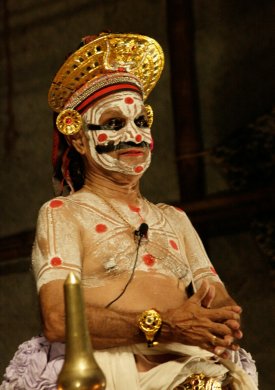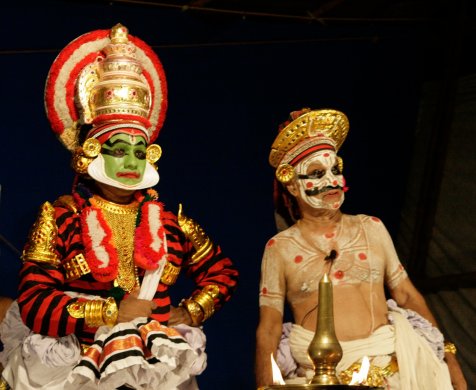 |
  |
 |
  |
Koodiyattam maestro P.K. Govindan Nambiar - Padma Jayaraj e-mail: padmajayaraj@gmail.com March 7, 2018  Chakyarkoothu and Koodiyattam are temple arts of Kerala. The origins of Chakyarkoothu can be traced to folk theater of Tamilnadu. Traditionally performed in temple theatres, it is dramatized dance worship by a group known as Chakyar, which began in feudal times and still continues as ritual worship. Association with Sanskrit drama helped it rise to a unique mimetic theatre with a history of 1000 years. Changed by daring stalwarts, the Sanskrit theatre has marched on to modern proscenium theatre of the world. It is believed that King Kulasekhara Varman of Chera dynasty introduced local language for Vidushaka and structured the play into well defined units. The Sanskrit theatre had a glorious time in the temples of Kerala where an exclusive group of caste Hindus of classical dimension enjoyed it in consonance with the beats of mizhavu drummers. When feudal patronage fell, the theatre began its journey on to public stage. Guru Mani Madhava Chakyar performed Koodiyattam for the first time outside the temple precincts in 1955 at Vaikkom. "I desired that this art should survive the test of time. That was precisely why I ventured outside the temple," his words confirm. The classical theatre, liberated from the hardliners, went on to other parts of India. It was the recognition of UNESCO that breathed in fresh air and saved a unique "masterpiece of oral and intangible heritage of humanity." Of course there are a number of theatre artistes who contributed their share for the evolution of this oldest classical theatre. P.K. Govindan Nambiar was one among them who followed the footsteps of his father and guru. Born in 1930 as the second son of the legendary artist Guru Mani Madhava Chakyar, P.K. Govindan Nambiar has the art in his genes. For him, the heritage became a way of life. He had his 'arangettam' at the age of 14. In those days, the life of an artist, especially temple arts like Koothu and Koodiyattam, was one of dedication. He has continued his pursuit of excellence in this field for more than seven decades now. Initiated by his father/ guru, Nambiar displayed an inexhaustible passion for his first love. Innumerable are his contributions. He has excelled not only as a classic performer of Koothu, Koodiyattam and Padhakam but also as a writer with a number of notable publications to his credit. A versatile artiste, he has performed on several stages outside the temple premises. Another notable contribution of Nambiar is his successful attempt in breaking the language barrier for the performance of Koothu and Koodiyattam beyond Kerala. An accomplished Hindi teacher, Govindan Nambiar took it as a challenge to perform Chakyarkoothu and the role of Vidushaka in Koodiyattam in Hindi, while performing outside Kerala. That proved a milestone like the effort of King Kulasekhara Varman. This was a great success as it enabled the Hindi speaking art lovers of north India to understand and enjoy these classical art forms of Kerala. Nambiar performed at Rashtrapathi Bhavan and on several stages across north India. He performed and documented the Purusharthakoothu in its entirety in the Kuttenchery Chakyar tradition in Hindi. He is the only Koodiyattam artist who has accomplished the feat of rendering the art form in Hindi. As a performing artist, Nambiar was aware of his social responsibilities and used his mastery over the art form in fulfilling them. He performed the traditional art form Padhakam over 2000 stages across rural and backward areas, under the patronage of the Song and Drama Division of Field Publicity Department, Government of India. These were not traditional performances but tailor made to spread messages of national importance like communal harmony, national integration, family planning, problems of alcoholism, illiteracy etc., through stories from Ramayana and Mahabharata. It proved an 'Art for Life's Sake' movement. He even did a few performances for the leprosy patients in the leprosy colony, Nooranad near Pandalam in Kerala. 

Nambiar has also contributed to the literary field related to Koothu and Koodiyattam where reference books available for future generation are quite limited. He translated 'Natyakalpadrumam,' the authentic book on Koodiyattam written in Malayalam by his father Mani Madhava Chakyar into Hindi. Other contributions include the book 'Vidooshakan' published by Kerala Sahitya Akademi in Malayalam, 'Vidooshak' published by Kendra Sangeet Natak Akademi in Hindi. The script of the noted film 'Nalukettu' written by M.T. Vasudevan Nair, Sukanya Charitham Nangiarkoothu, Rugmangada Charitham, and Chambu Prabandham etc, found their Hindi versions. Dedicated to his selfless pursuance of these art forms, Nambiar neither cared nor had the time to think of awards and recognitions. However, over the last seven decades of his performing career, several recognitions have come his way. These include the Kendra Sangeeta Nataka Akademi Award, Senior fellowship from Department of Culture, Best Teacher Award of Kerala State, and UNESCO recognition as "Koodiyattam Guru" to mention a few. Nambiar has worked as the honorary secretary of Kunchan Nambiar Memorial for 12 years and is one of the founders and gurus of Mani Madhava Gurukulam which imparts training in the fields of Koodiyattam and Koothu for budding artists. Padma Jayaraj is a freelance writer on the arts and a regular contributor to www.narthaki.com. Post your comments Please provide your name and email id along with your comment. All appropriate comments posted with name and email id in the blog will also be featured in the site. |